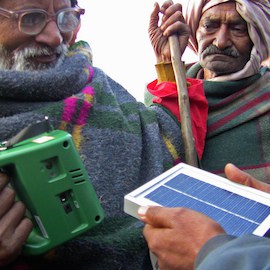Critics: Give Development Impact Bonds a Chance to Learn to Walk Before They Run
In December The Stanford Social Innovation Review published an opinion piece by Kevin Starr in which he raised questions around Development Impact Bonds (DIBs). As a co-founder of the Delta Fund, a donor-advised fund focused on issues around poverty and equity, I wanted to respond with our experiences and observations to date. While DIBs are in their infancy, they show quite a bit of promise. And while constructive criticism shouldn’t be dismissed, I’ll explain why the the focus for now should be on improving, not disparaging or dismissing the models.
At the Delta Fund, we have been working in impact investing broadly and DIBs specifically for the past four years. We are the lead investors in the Village Enterprise DIB committing $1 million and are investors in other newer models. Our interest in this work rises from a desire to meet the growing interest of investors to tie their real-world investments to meaningful outcomes in the world. As surveys continue to show, a growing generation of investors are interested in the real-world impacts of their savings – not just the dollars returned.
We believe that structures like DIBs will create an opportunity to attract more funding to development in a more scalable manner while also driving positive operational improvements and innovation into development.
The ‘risk reduction premium’ will normalize and DIB costs will decrease.
The bulk of Starr’s piece focused on a rather shallow theoretical thought exercise on the financials surrounding DIBs. The two main criticisms fall into a) high costs and b) whether the investor returns are justifiable.
DIBs today are a first attempt at designing systems that are admittedly more complicated than a straight grant or donation. DIBs require systems for measurement, contracts that are new to the world of investing, payout models from the outcome payer to the investor and teams to execute the programs on the ground. As these systems are new, they have not been optimized and improved with each completed DIB and lessons learned over time.
One of the greatest opportunities for reducing the costs in DIBs comes through scaling and normalizing these programs. Today almost everything is new, but as more DIBs are executed measurement costs will decrease, contracts will become more templatized, tracking systems will be created and so on. Economies of scale will help reduce the costs associated with DIBs today. Just like any new effort, startup costs are always the highest.
Regarding the aspect of investors making money from DIB’s success – and even more money as they scale – why should we feel better about people making money from carbonated sugar water but not innovation in the systems that help the poorest? And why should we feel bad if an investor receives a strong return for a particularly risky program that wouldn’t receive philanthropic funding, yet far exceeds the outcomes? Isn’t that innovation a benefit of these incentives?
Worth noting is that there is a downside as well if the programs fail. Investors take on the risk and may not receive a return – and even may lose money – if the programs don’t deliver. Rather than government institutions taking on that risk, they can pass it along to the investor. This is great for the public, whose tax dollars today fund significant development dollars globally. While in a specific deal you could argue that there is overpayment, in a broad portfolio the outcome payers have significantly reduced risk and are likely to see significantly less waste. In a world where oil companies continue to see significant subsidies, I doubt people will rise up over payments to investors who fund the creation of successful programs for the poor.
Finally, market forces will control overpayment over time, if:
- deals trend toward overpayment to investors, agreements will move to lower caps and structures to limit returns.
- you keep in mind that the new investor motivation will include both financial and social returns.
- financial isn’t the only outcome measured, then investors will find more tolerance with capped outcomes.
In our work, our investment in the Village Enterprise DIB is capped with upside returned to the organization to fund further future impact. We also are investing from a donor advised fund, so any return on the investment will be returned for new philanthropic opportunities.
Driving better measurement and operations in development
While DIBs bring more complexity into development, that complexity also brings improved accountability and operational excellence. Organizations rally around a time-bound goal that requires them to improve their programs and their outcomes. Teams rally around the goals and strive to improve their field level operations. It is early, but we are seeing this with the Village Enterprise DIB. Even in Starr’s example, the Educate Girls project, “had to go flat-out in the third year to make up for stutters in the first two.” To me, the DIB drove the right behaviors in that third year and hopefully informed higher quality work from the organization moving forward.
These trends for better understanding and measuring the outcomes organizations create, combined with increased operational rigor that is tied with many of these new models – including DIBs – is one of the more positive evolutions in development.
Some practical steps
Rather than rushing to a premature judgement on DIBs, I suggest that we are at the very beginning of the proofs of concept for these models. We will soon enter a phase where we see expansion in the types and locations for this work, and will see a boost in learning from successes and failures. A single DIB isn’t going to prove the model one way or another – rather these systems that show promise will benefit from learnings this decade.
As such, I would offer the following counter options to further develop DIBs as a viable mechanism for funders and NGOs alike:
Better define impact. Organizations involved in development need to push past the marketing language of impact to more specific outcome definitions that can be measured.
Improve measurement. In support of those definitions of outcomes, new systems of measurement that can draft off of decades of advanced measurement in medicine and other fields need to be created. Not only do these support structures like DIBs but then enable organizations to test, learn and improve their models.
Develop the systems to reduce costs. This applies to contracting, measurement and management. In order to operationalize these newer models, we need to share our best practices as an industry, set benchmarks for outcomes, share templates for agreements, and create systems to help organizations execute.
Test and learn. Across all of these suggestions, we need to learn from every phase of DIBs that run and strive for open sharing between investors and outcome providers. The primary motivation here isn’t a financial one in which having an edge matters.
Building for a new future in development
Development Impact Bonds are in their infancy with the very first test of the concept launched in 2010. Any new system requires time, investment and optimization before we can scale it to the theoretical potential. That said, we are already learning from the first handful of DIBs that have launched in the world.
One could conclude that Starr wishes people would just do the right thing and fund the programs that would make a difference in the world. I so wish that would happen… but it isn’t. Billions of dollars in foundations and DAFs are sitting on the sidelines contributing to the traditional financial systems – sugary soda water investments and more – when they could be better put to work here.
A new generation of investors wants a blended financial and social return. And in order to meet these growing needs, we will need new models and systems to support a potentially world-changing pool of resources helping to propel development forward.
Brian Boland is the Co-Founder of the Delta Fund, a donor-advised fund focused on poverty alleviation and justice reform.
Top image: Members of Jobesa business group in Amuria, Uganda – a business created through the Village Enterprise DIB. (Image courtesy of the author).
- Categories
- Investing



